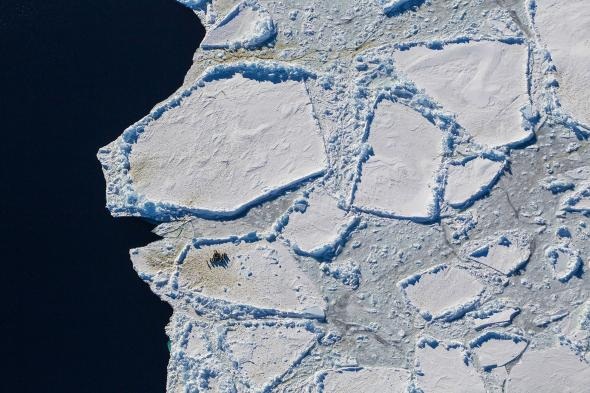Scientists Are Watching in Horror as Ice Collapses

The soldiers at Matienzo Base in Antarctica made an odd discovery in January 1995—an antique dog sled, unlike any they had ever seen, bound together by leather straps, with a label reading “Made in England.” Matienzo was an Argentine research base on a small island 30 miles off the coast of the Antarctic Peninsula. It was surrounded by a vast plain of white—a slab of glacial ice, 700 feet (215 meters) thick, that floated on the ocean. That floating slab, called Larsen A Ice Shelf, covered an area of water the size of San Francisco Bay. It had existed for a thousand years or more. But this hot summer it looked strange. The men had to go onto the ice shelf to collect snow for drinking water, and it made them uneasy. The ice shelf was crisscrossed with narrow cracks—which the men nervously jumped over—and dotted with deep blue melt ponds. It was there, protruding from a melt pond, that they found the sled. It must have been discarded by a British expedition that passed through decades before. That old sled turned out to be an omen of disaster, like a long-buried coffin that resurfaces when a city is ravaged by floods. It showed that Larsen A had been quietly deteriorating for years.
Discarded so long ago, the sled should have been buried under many feet of snow, but a series of hot summers had melted it free. Melting of the ice shelf’s protective skin of snow had re-exposed old wounds. The cracks that the men jumped over were deep crevasses that had formed on the surface centuries before, been buried under tens of feet of snow, and then re-emerged. The hot summers had also damaged Larsen A in another way: As the meltwater refroze each winter, the shelf's porous upper layers condensed into a watertight barrier of ice, which was capable of accumulating increasingly large melt ponds during the summers. In February 1995, a few weeks after the sled was discovered, these odd symptoms converged catastrophically. Larsen A shattered like a windshield into thousands of icebergs, each larger than an aircraft carrier. Booms erupted from the fracturing ice, and the island shook. The 10 soldiers feared that their island would break from its foundations, roll into the ocean, and kill them all. The disintegration of Larsen A, which I wrote about for Scientific American in July 2012, unfolded over a period of just hours. The soldiers at Matienzo Base watched in horror but were not injured. The catastrophic collapse of Larsen A and several other ice shelves along the Antarctic Peninsula has yielded important lessons about the vulnerability of Antarctica’s ice sheets to a warming climate. A new analysis of ice sheet instability, published March 31 in Nature, took the public by surprise when it projected that global sea level might rise six feet by 2100, and as much as 40 to 50 feet by the year 2500. (Read "Why the New Sea Level Alarm Can't Be Ignored.") That study seemed to double, overnight, the amount of sea level rise that can be expected. But many glacial scientists weren’t surprised. The new estimate is based on insights that have emerged slowly, over 20 years, in the aftermath of these ice shelf collapses.
The Aftermath of an Ice Shelf Collapse
Explore the fjords along the northeastern Antarctic Peninsula today, and it’s easy to find landscapes that look scarred even to the casual observer. The walls of these canyons remind me of lacerated skin where the scab was torn off. When I explored one of these fjords on foot, in 2010, the scar ran along the walls of the fjord—swaths of gray gravel and stone that looked pale compared with the darker, browner mountains above.The lower reaches of the canyon walls were pale because the rock had only recently come in contact with sunlight and air. Until 15 years ago, these slopes were covered by thick glacial ice. The glacier, now absent, had retreated several miles into its fjord. The fjord used to hold 2,000 feet (600 meters) of ice. Now it held 2,000 feet of seawater instead. The aftermath of an ice shelf collapse is obvious in Sjögren’s fjord. When the ice shelf in front of Sjögren disintegrated in 1995, it removed the buttress that stabilized the glacier. The glacier started sliding into the sea at twice its original speed. Sjögren erupted in crevasses and thinned by several hundred feet as it stretched. After a few years, the glacier had retreated miles into its fjord as icebergs splintered off the glacier’s front faster than the ice could flow forward.
Read more:http://news.nationalgeographic.com/2016/04/160412-ice-sheet-collapse-antarctica-sea-level-rise

